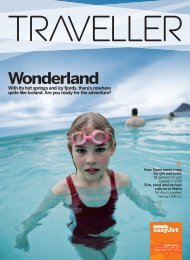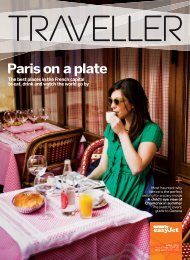november-2010
november-2010
november-2010
You also want an ePaper? Increase the reach of your titles
YUMPU automatically turns print PDFs into web optimized ePapers that Google loves.
Advertorial<br />
The Yamaha<br />
Digital Piano<br />
Story<br />
With a rich heritage of traditional piano manufacturing dating back to the late<br />
19th Century and a reputation as leaders in digital music and audio technology,<br />
Yamaha is uniquely qualified to develop the latest generation of pianos.<br />
Digital Pianos, first introduced in the 1980s, use<br />
electronic waveform generation to emulate the sound of<br />
their acoustic counterparts. They never need tuning, can<br />
be used for silent practice on headphones and in many<br />
cases, can play other instrument sounds too. And many<br />
models are light and portable, making them ideal for<br />
professional musicians.<br />
Yamaha were pioneers in the use of sampling to further<br />
enhance the accuracy of their digital piano sound.<br />
For purity of purpose in digital pianos, look no further than<br />
the Yamaha CLP Clavinovas. CLP models are chosen by<br />
many of the world’s leading music schools and<br />
conservatoires, yet with a wide selection of cabinet styles<br />
and finishes, including the new Slimline variants, they are<br />
equally suited to home use.<br />
Digital electronics also present many more opportunities to<br />
the musician, especially in the home. Today’s CVP Clavinova<br />
range offers literally hundreds of different instrument<br />
sounds, including drums and many automatic<br />
accompaniments that make you sound and feel like you<br />
have a whole orchestra behind you.<br />
There’s a price advantage too. The latest P-Series models<br />
pack amazingly realistic sounds into compact, portable<br />
packages, perfect for the gigging musician,<br />
home studio setups or simply the joy of<br />
playing piano.<br />
By adding more features,<br />
sounds and backing styles,<br />
the DGX range of “Portable<br />
Grands” combines piano<br />
functionality with workstation<br />
performance for home music<br />
producers.<br />
AvantGrand<br />
“Sampling” is a technique where multiple recordings are<br />
made of a real piano and stored on memory chips. These<br />
recordings can then be played back by the keyboard. But<br />
the tone of a single piano note changes when you play it<br />
louder or more softly. Using intelligent software, and still<br />
more samples, Yamaha is able to reproduce this effect to<br />
generate a digital piano sound which is indistinguishable<br />
from it’s acoustic source. On some instruments, even the<br />
sampled sound of sympathetic string, damper and<br />
soundboard resonance is used to complete the illusion.<br />
Meanwhile the Arius range is a great introduction to<br />
Yamaha’s digital piano family and includes many of the<br />
features of our top models yet it is affordable to beginners<br />
and students alike.<br />
For those with an eye for design, Yamaha MODUS offers<br />
contemporary style with uncompromised performance.<br />
Yamaha’s latest digital piano development is the astonishing<br />
AvantGrand. In fact the term “digital piano” doesn’t quite do<br />
AvantGrand justice. Because it uses a real wood keyboard<br />
and a specialised grand piano action, Yamaha call it a Hybrid<br />
Piano. The sound is without peer and the<br />
Spatial Acoustic Speaker System,<br />
Soundboard Resonator and Tactile<br />
Response System involve the pianist in<br />
a way no other digital instrument<br />
can. It’s the ultimate piano<br />
experience.<br />
europe.yamaha.com<br />
P Series<br />
DGX<br />
Arius<br />
CLP<br />
CVP<br />
Modus















